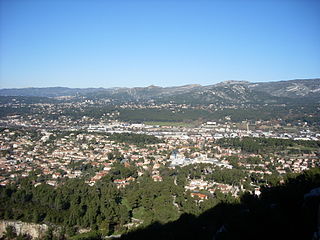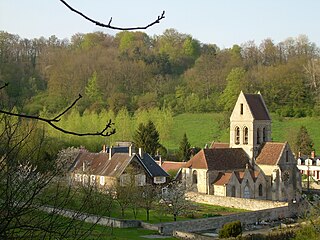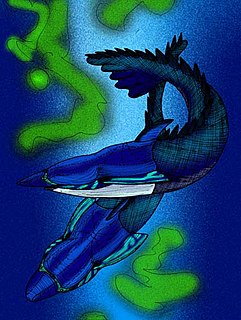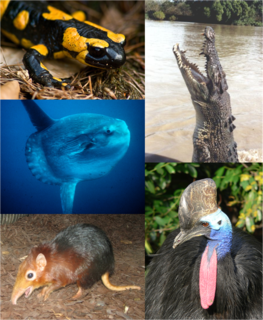
Milhaud is a commune in the Gard department in southern France. The place name Milhaud is derived from the Roman family name Aemilius with the suffix -avus.
A pseudonym or pen name, also known by its native names hao, gō, ho and hiệu, is a professional name used by East Asian artists. The word and the concept originated in China, then became popular in other East Asian countries.

Pomace brandy is a liquor distilled from pomace that is left over from winemaking, after the grapes are pressed. It is called marc in both English and French, but "grappa" in Italian. In Spain it is sometimes called marc, but more usually orujo. Alcohol derived from pomace is also used as the traditional base spirit of other liquors, such as some anise-flavored spirits. Unlike wine brandy, most pomace brandies are neither aged nor coloured.

Aumale, formerly known as Albemarle, is a commune in the Seine-Maritime department in the Normandy region in north-western France. It lies on the river Bresle.

Protaspididae is an extinct family of pteraspidid heterostracan agnathans. Fossils of the various genera are found in early Devonian-aged marine strata. Protaspidids were once thought to represent a transitional form between the Pteraspididae and the Psammosteida, bearing the broad head shield shape of the latter, due to a more benthic (bottom-dwelling) existence, but recent phylogenical comparisons demonstrate that the protaspidids are actually highly derived pteraspidids, and that the anchipteraspidids, the most primitive of pteraspidids, are the sister-group of the Psammosteids.

Bourbon-Lancy is a commune in the Saône-et-Loire department in the region of Bourgogne in eastern France.

La Grand-Combe is a commune in the Gard department in southern France.

La Penne-sur-Huveaune is a commune east of Marseille and west of Aubagne along the A50 autoroute in the department of Bouches-du-Rhône in the Provence-Alpes-Côte d'Azur region in southern France.

Sorona is DuPont's brand of triexta. It was named and commercialized in 2000. The fibers are claimed to be both soft and extremely stain resistant, while exhibiting high strength and stiffness

Chaillevois is a commune in the Aisne department in Hauts-de-France in northern France.

Saint-Léger-du-Bourg-Denis is a commune in the Seine-Maritime department in the Normandy region in northern France.
Du und Du, opus 367, is a waltz by Johann Strauss II composed in 1874. It derives from themes from his Die Fledermaus, the famous operetta, and its title and opening melody specifically from the Du-i-Du chorus of Brüderlein, Brüderlein und Schwesterlein in Act II.

Piperoxan, also known as benodaine, is a drug which was the very first antihistamine to be discovered. This compound, derived from benzodioxan, was prepared in the early 1930s by Daniel Bovet and Ernest Fourneau at the Pasteur Institute in France. Formerly investigated by Fourneau as an α-adrenergic-blocking agent, they demonstrated that it also antagonized histamine-induced bronchospasm in guinea pigs, and published their findings in 1933. Bovet went on to win the 1957 Nobel Prize in Physiology or Medicine for his contribution, and one of their students, Anne-Marie Staub, published the first structure-activity relationship (SAR) study of antihistamines in 1939.

Gravisauria is a clade of sauropod dinosaurs consisting of some genera, Vulcanodontidae and Eusauropoda.
Djurinaspis is an extinct genus of jawless fish which existed during the early Devonian period. It was originally described by Novitskaya in 1983. A new species, D. secunda, from Ukraine was described by Victor Voichyshyn in 2011.

Panamintaspis snowi is an extinct species of pteraspidid heterostracan agnathan which existed during the early Middle Devonian period of Death Valley, California. Fossils are found in Late Emsian-aged marine strata of the Lost Burro Formation. P. snowi strongly resembles Pteraspis, though while it was originally described as a member of the same family, Pteraspididae, a recent phylogenetic reassessment of the order Pteraspidiformes places P. snowi within the paraphyletic family "Protopeteraspidae," as the sister taxon of the suborder Pteraspidoidei.

Protopteraspididae is an extinct family of pteraspidid heterostracan agnathans. Fossils of the various genera are found in early Devonian-aged marine strata. Protopteraspidids were once thought to represent a taxon of basal pteraspidids but recent evaluations demonstrate that Protopteraspididae is a paraphyletic group of various transitional forms representing a gradual transition between the more advanced Pteraspoidei, and the anchipteraspidids and the Psammosteids.
Anchipteraspididae is an extinct family of heterostracan vertebrates restricted to Late Silurian and Early Devonian strata of Arctic Canada.
















